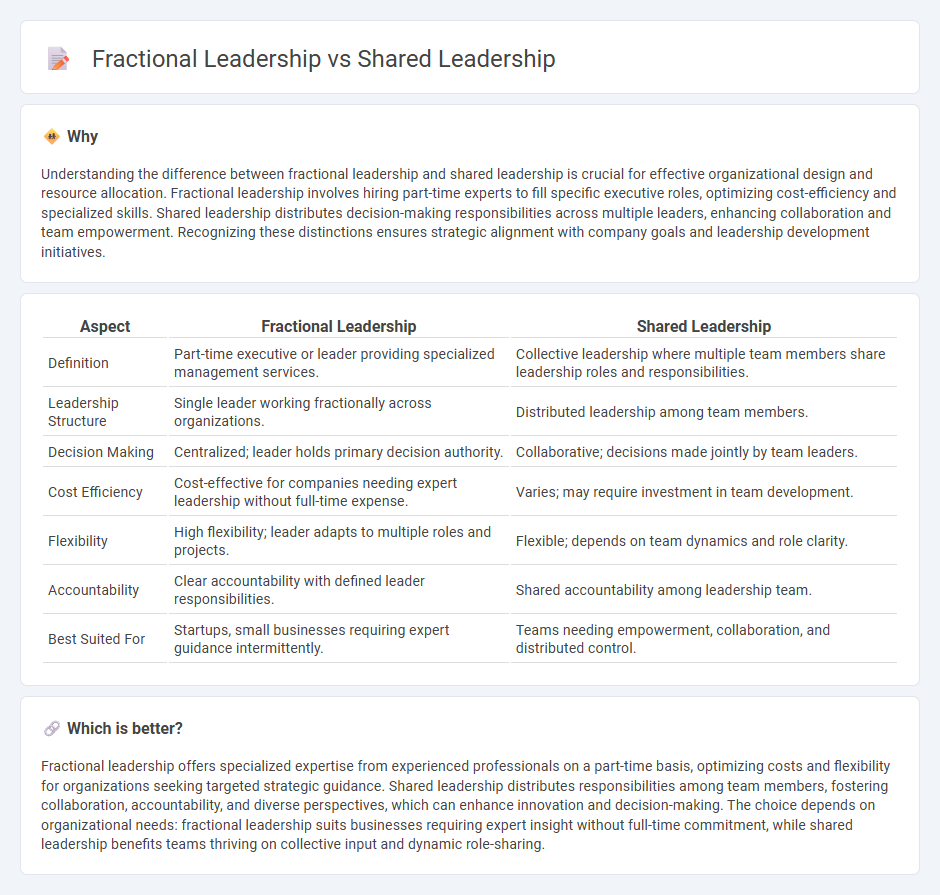
Fractional leadership involves hiring part-time executives who bring specialized expertise to guide specific areas of a business, optimizing resources and strategic focus. Shared leadership distributes decision-making responsibilities across team members or departments, fostering collaboration and diverse perspectives to enhance organizational performance. Explore the nuances and benefits of fractional versus shared leadership to determine the best fit for your business needs.
Why it is important
Understanding the difference between fractional leadership and shared leadership is crucial for effective organizational design and resource allocation. Fractional leadership involves hiring part-time experts to fill specific executive roles, optimizing cost-efficiency and specialized skills. Shared leadership distributes decision-making responsibilities across multiple leaders, enhancing collaboration and team empowerment. Recognizing these distinctions ensures strategic alignment with company goals and leadership development initiatives.
Comparison Table
| Aspect | Fractional Leadership | Shared Leadership |
|---|---|---|
| Definition | Part-time executive or leader providing specialized management services. | Collective leadership where multiple team members share leadership roles and responsibilities. |
| Leadership Structure | Single leader working fractionally across organizations. | Distributed leadership among team members. |
| Decision Making | Centralized; leader holds primary decision authority. | Collaborative; decisions made jointly by team leaders. |
| Cost Efficiency | Cost-effective for companies needing expert leadership without full-time expense. | Varies; may require investment in team development. |
| Flexibility | High flexibility; leader adapts to multiple roles and projects. | Flexible; depends on team dynamics and role clarity. |
| Accountability | Clear accountability with defined leader responsibilities. | Shared accountability among leadership team. |
| Best Suited For | Startups, small businesses requiring expert guidance intermittently. | Teams needing empowerment, collaboration, and distributed control. |
Which is better?
Fractional leadership offers specialized expertise from experienced professionals on a part-time basis, optimizing costs and flexibility for organizations seeking targeted strategic guidance. Shared leadership distributes responsibilities among team members, fostering collaboration, accountability, and diverse perspectives, which can enhance innovation and decision-making. The choice depends on organizational needs: fractional leadership suits businesses requiring expert insight without full-time commitment, while shared leadership benefits teams thriving on collective input and dynamic role-sharing.
Connection
Fractional leadership and shared leadership both emphasize distributed decision-making and resource optimization within organizations, allowing multiple leaders to collaboratively influence strategy and operations. Fractional leadership allocates specific executive roles on a part-time basis, while shared leadership involves collective leadership responsibilities distributed among team members. Their connection lies in enhancing organizational agility and leveraging diverse expertise to drive business performance.
Key Terms
Collaborative Decision-Making
Shared leadership emphasizes collaborative decision-making by distributing authority across team members, fostering collective responsibility and diverse perspectives. Fractional leadership involves hiring external leaders to manage specific functions part-time, bringing targeted expertise without full-time commitment. Explore how each approach enhances organizational agility and innovation.
Distributed Authority
Shared leadership distributes authority among team members, promoting collaboration and collective decision-making to enhance organizational agility. Fractional leadership allocates leadership roles to part-time experts who provide specialized guidance while maintaining operational flexibility. Explore more about how distributed authority transforms leadership models for dynamic business growth.
Time Commitment
Shared leadership involves multiple leaders collaboratively managing responsibilities with flexible time allocation, fostering diverse input and balanced workload distribution. Fractional leadership features part-time executives dedicating specific hours to organizations, offering specialized expertise with efficiency and cost savings. Explore key differences in time commitment to determine which leadership model best suits your organization's needs.
Source and External Links
Shared Leadership | EBSCO Research Starters - This webpage describes shared leadership as a collaborative approach where multiple individuals share responsibilities and authority, differing from traditional hierarchical leadership models.
Shared Leadership - Wikipedia - This article provides an overview of shared leadership, defining it as a process of influence among team members that leads to mutual responsibility and shared power.
What is Shared Leadership and Why Now? - Interaction Institute for Social Change - This article explores shared leadership as a decentralized model that fosters transformational collaboration and equal power distribution within organizations.
 dowidth.com
dowidth.com